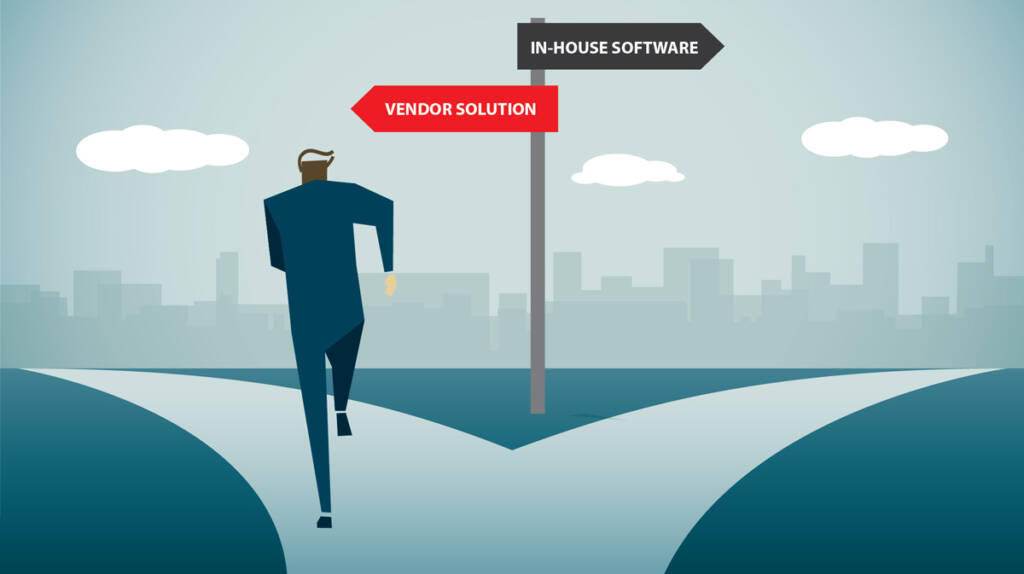Compliance Crossroads Part Two: Switching From In-House Software To A Vendor Solution
Depending on the size of your organization, you may have spent hundreds of thousands or even millions of dollars to build and maintain your in-house compliance software. The question is, can the software keep up with your needs? Or is it only solving for the bare minimum?
Last week, in part one of this two-part blog series, we learned that many enterprise financial firms in the last five years—more than 50% of Star clients—have jumped the internal-build ship to go with solutions maintained by companies whose sole job it is to build compliance software. We offered you four benefits of making such a switch, and today offer the remaining seven.
NEW FEATURES FASTER
Technology is constantly evolving, responding to the needs of business and even anticipating them. New features are what keep any software platform fresh, and therefore relevant. But building out new features is, in all the important ways for this discussion, like developing a piece of software from scratch. You still need to gather requirements, staff the project, write the code, test it, and so on. It’s no easy task getting a new feature off the ground, even if you have the base system fully up and running. And by the time you do get around to launching it, some more-critical feature could have slipped through the cracks. If software needs to be fresh to do its job properly, freshness implies speed, and speed implies expertise. And expertise at taking a piece of software from conception to launch is what compliance software vendors do best.
THE POWER OF APIs
The ability to connect internal and external systems—or complementary compliance systems like control room—will exponentially increase the effectiveness of your primary compliance platform. APIs give clients extensibility—the ability to create connection points—between the enterprise software they have in place, to leverage data across systems and minimize data duplication. But all APIs aren’t created equal. Flexible and able to connect systems of all kinds, the best APIs—built by dedicated compliance software firms like Star—offer client companies the opportunity to connect seamlessly and easily, with minimal lift.
THE POWER OF PRE-BUILT INTEGRATIONS
Pre-built integrations are exactly what they sound like. They come pre-built in a software system and require little to no additional setup. They allow for seamless integration with and access to relationships a company like Star has already established with other vendors in the marketplace. Broker feeds. Security masters. Political donations databases. Global news sources. Pre-built integrations allow client firms to leverage data and information sources they likely would never be able to with a homegrown compliance platform.
PUSHING DATA DOWN TO THE FIRST LINE
One recommendation of a recent McKinsey report on where compliance is and where it should go, is the need for enterprise financial firms to “strengthen risk ownership in the first line.” To do this, you need reporting that can keep up. Most in-house systems don’t come with reporting functionality, and they definitely don’t come with dashboard visualizations. For an in-house team, building such a capability would be a huge lift. For optimal functionality, you’d want to design and develop a data warehouse—a significant expense in time and money for a single organization. A strong vendor solution will come with substantial in-house reporting capabilities that don’t require additional hours in Excel to actually obtain insights from the data.
TAKING COMPLIANCE MOBILE
Mobile compliance apps increase employee participation, enhance data accuracy, and decrease manager response times. But while the benefits of such apps are clear and manifold, so are the costs to develop them. Because good apps aren’t just smaller versions of the desktop app. They’re built from scratch specifically for mobile devices, with user interfaces that make the most of the limited screen space users have to deal with. This is a skillset in and of itself, and one modern software firms are always working to get better at—because an increasingly mobile world demands it.
A RECOGNIZED PLATFORM
Since part of reducing regulatory risk is ensuring regulators have an increased level of confidence in an organization’s compliance controls before, during, and after audits, a vendor solution other organizations are using is likely to be more easily recognized and understood by an audit team. This in turn provides an increased level of confidence in your organization.
Regulators are also not just increasingly accustomed to interacting with vendor software, but also increasingly expecting companies to employ compliance software built buy vendors, i.e., experts in the field. As covered in a recent StarCompliance blog, FINRA is at the point of expecting financial firms to use third-party vendors to meet their compliance software needs.
SCALE AND ADAPTABILITY
Counterintuitively perhaps, a common platform is often more adaptable to your organization’s needs than an in-house platform. This is because a vendor has to satisfy such a large cross section of requirements from a wide range of users. As such, a common-platform application can often more easily tolerate changes of requirement and scope, allowing necessary changes via the user interface without the need for further, costly development.
But in addition to this inherent adaptability—even down to the rules engine, which is fully configurable and based on your policies and rules—a good vendor can also customize a client’s platform down to the individual user or group level. For organizations with employees across the globe, this means the ability to vary language, time zone, local currency, and more based on where individuals are located. For compliance teams, this means the ability to create groups with varying levels of authorization based on their role within the organization.
Also, most in-house systems don’t have robust data-visibility rights and permissioning features: important to firms that have multiple verticals and levels. With in-house platforms, customizations like these are wish-list items, but for a software vendor it’s all in a day’s work.
SWEET, SWEET FREEDOM
Vendors are software experts. Development isn’t a sideline. A software vendor’s survival relies on maintaining the expertise of its team and the constant updating of its product. And the client-vendor relationship applies perfect pressure to ensure the common-platform product stays moving in the right direction: taking changes in the markets, regulations, and technology and synthesizing them seamlessly.
With the vendor shouldering all responsibility for requirements gathering, implementation, development, and product support, you’re left free to concentrate on your core business activities and higher-value compliance responsibilities. When you buy a compliance platform, therefore, one of the most important things you’re buying is freedom.
Compliance Platform Buyer’s Checklist




